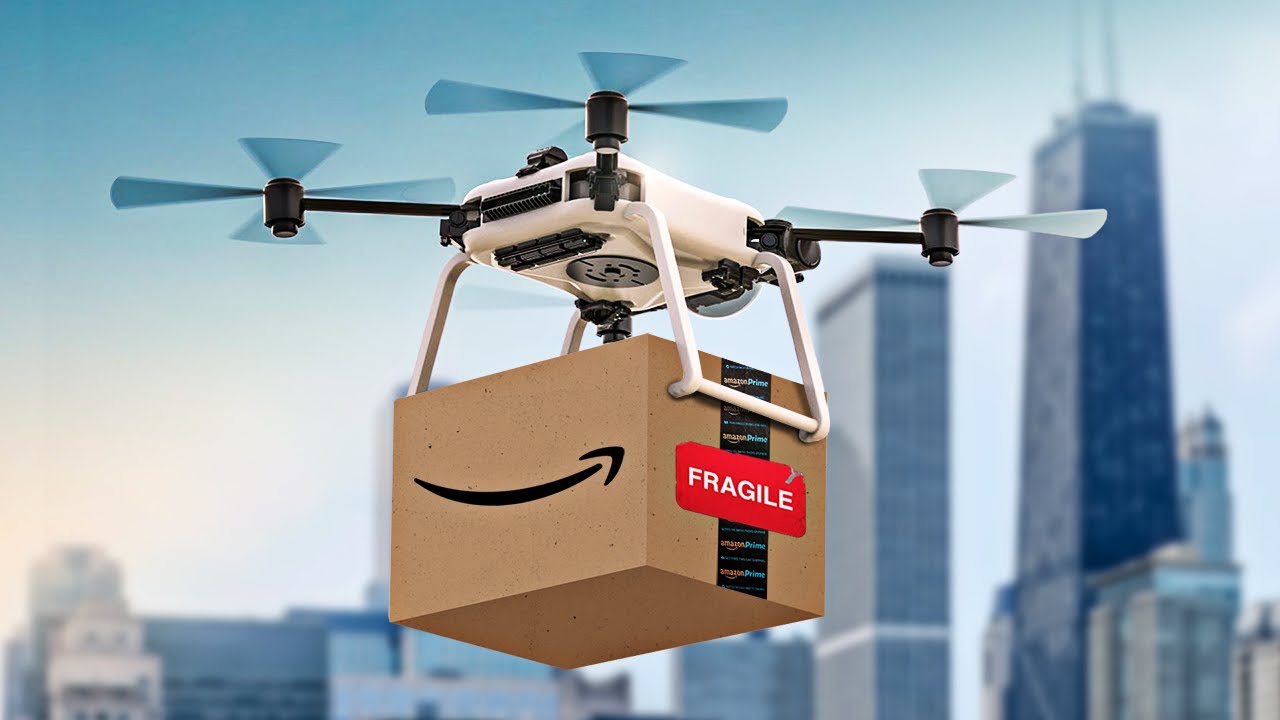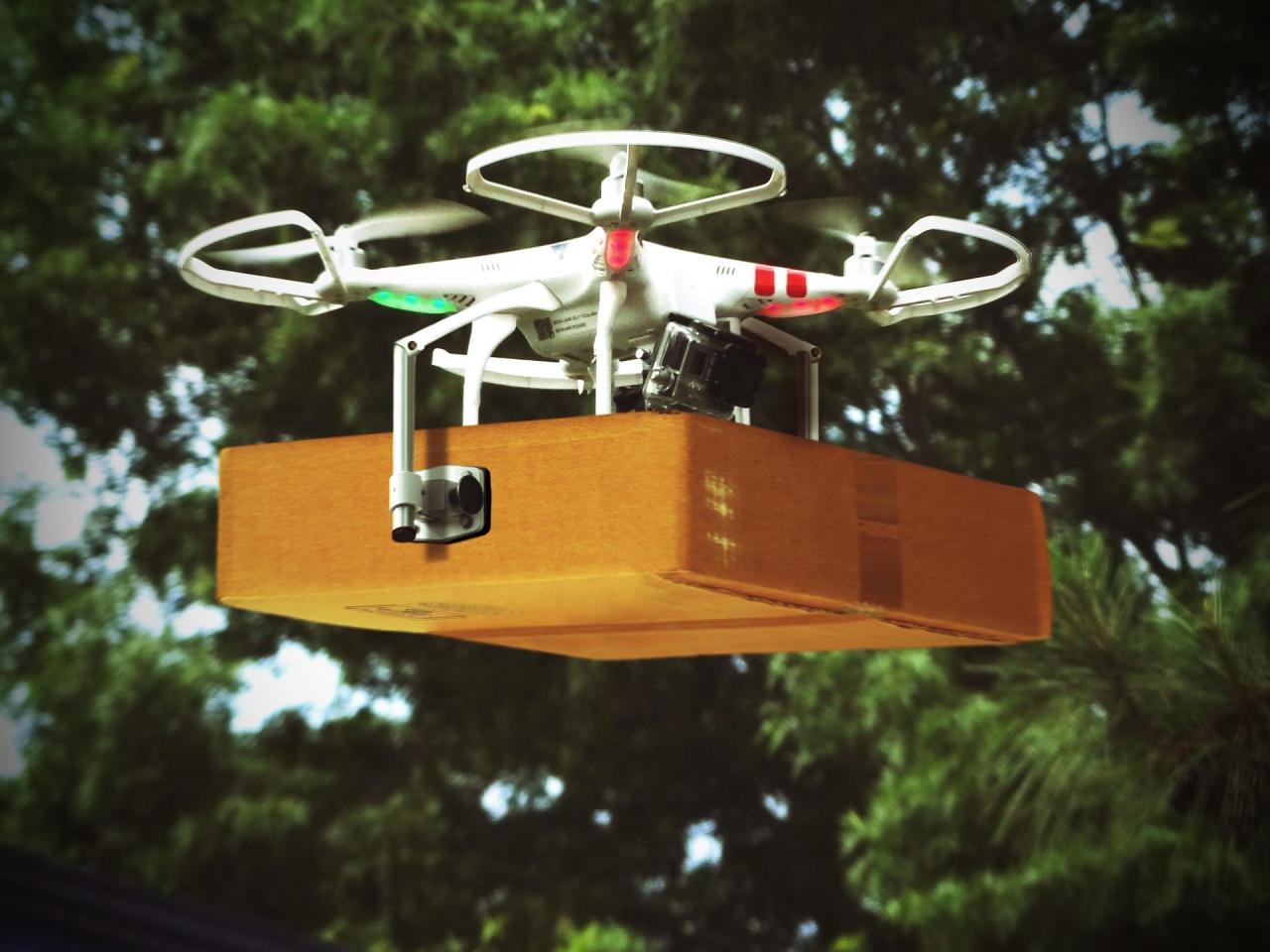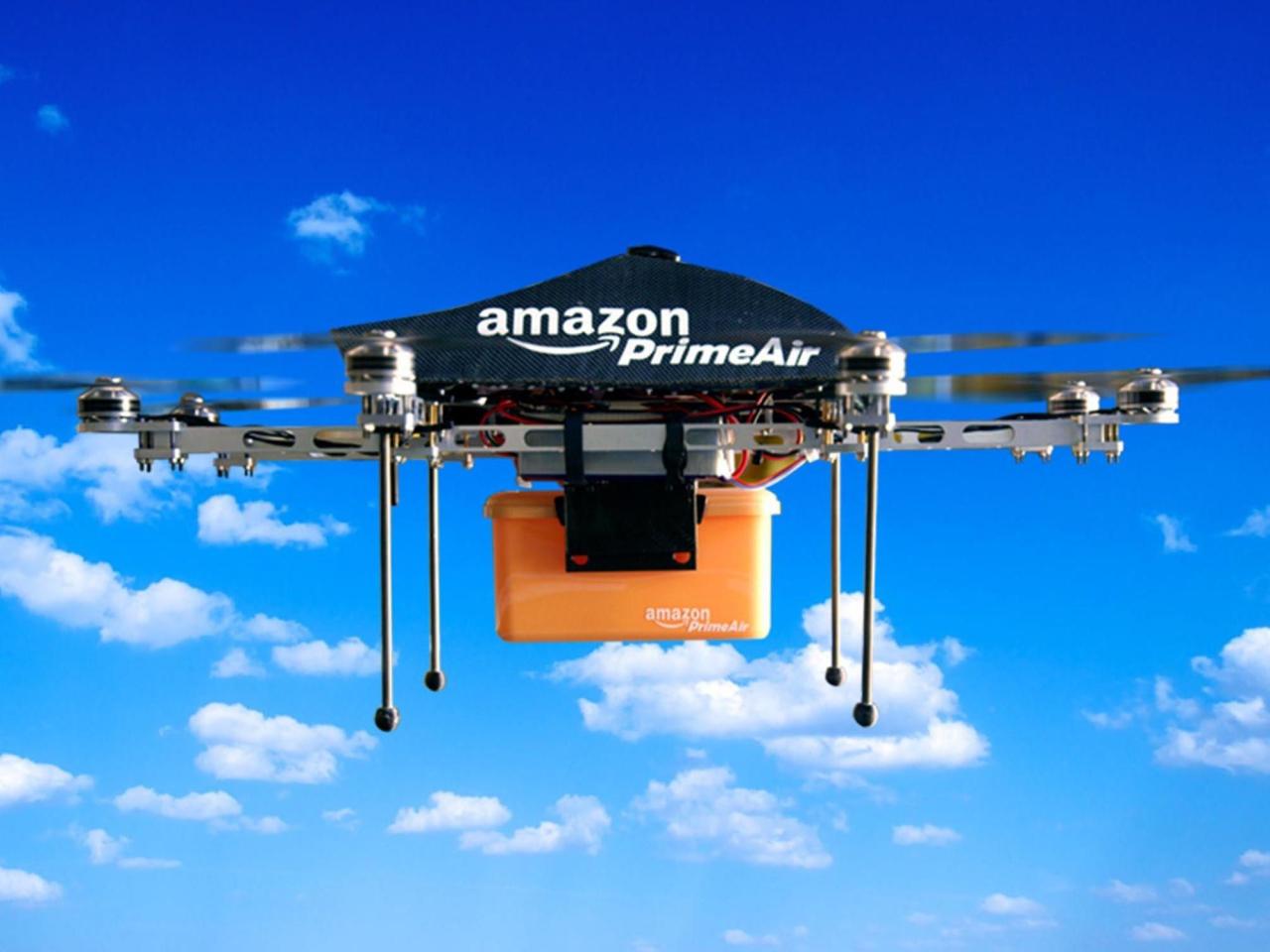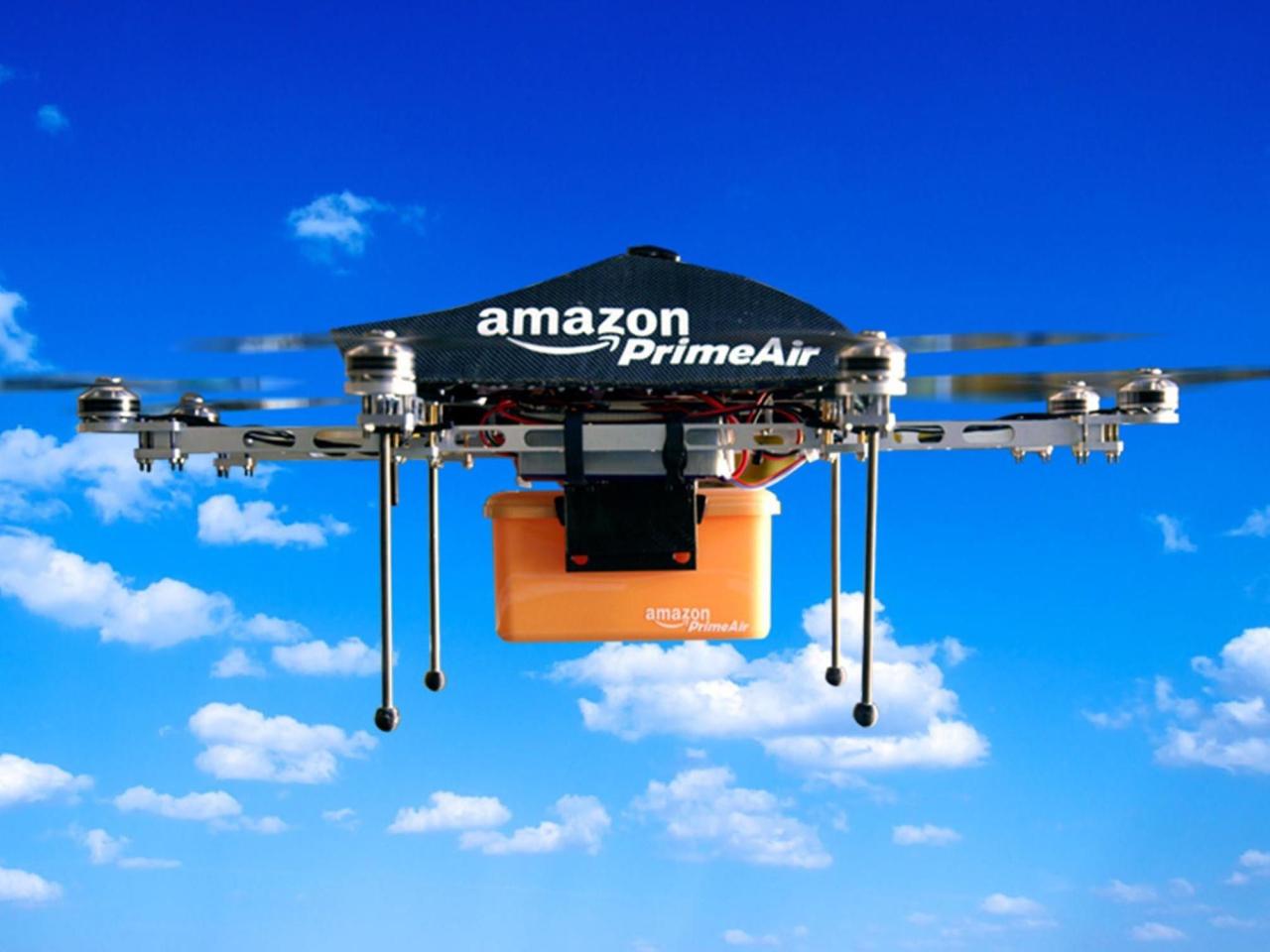Amazon drone delivery locations are rapidly expanding, marking a significant shift in the logistics industry. This exploration delves into the current status of Amazon’s drone delivery program, examining the geographical reach, package eligibility, and technological infrastructure involved. We’ll also analyze the factors influencing location selection, including logistical challenges, regulatory hurdles, and infrastructure requirements. Finally, we’ll look at future expansion plans, customer experiences, and the environmental impact of this innovative delivery method.
Understanding the intricacies of Amazon’s drone delivery network requires considering various perspectives. From the technological advancements driving the program to the regulatory landscapes shaping its growth, each element plays a crucial role in determining where and when drones deliver packages. This overview aims to provide a comprehensive understanding of this evolving system.
Amazon Drone Delivery Program: Current Status and Future Outlook

Amazon’s drone delivery program, Amazon Prime Air, represents a significant advancement in last-mile delivery. This article delves into the current state of the program, exploring its geographical reach, technological underpinnings, and future expansion plans, alongside considerations for customer experience and environmental impact.
Current Amazon Drone Delivery Program Status
Amazon Prime Air’s current operational scope is limited to specific regions in the United States, primarily focusing on areas with suitable infrastructure and regulatory approvals. The program is gradually expanding, but it’s still in its early stages of widespread deployment.
Currently, eligible packages are typically smaller and lighter items, often those that can be easily contained within the drone’s delivery compartment. This limits the range of products available for drone delivery, but Amazon continues to explore ways to expand this range as technology improves.
Amazon’s drone delivery system relies on a complex network of infrastructure, including sophisticated drone technology, GPS navigation, air traffic management systems, and advanced logistics software. This infrastructure ensures safe and efficient delivery, requiring substantial investment in both hardware and software development.
So you’re curious about where Amazon’s drone deliveries are headed? They’re expanding rapidly, testing different areas for efficiency. To get a better idea of the tech involved, check out the innovative drone designs from sky elements drones ; their advancements could easily influence Amazon’s future delivery systems. Ultimately, understanding the technology behind these drones helps us predict where Amazon might expand its drone delivery locations next.
Drone delivery offers significantly faster delivery times compared to traditional methods, particularly for shorter distances. While efficiency is still being optimized, the potential for reduced delivery times and operational costs is considerable. The speed advantage is most noticeable in areas with congested traffic or limited road access.
Factors Influencing Drone Delivery Location Selection

Expanding drone delivery locations presents several logistical challenges. These include ensuring reliable airspace management, establishing secure drone landing zones, and addressing potential safety concerns related to drone operations in populated areas.
Regulatory hurdles vary significantly across different regions. Obtaining necessary permits and approvals for drone operations often involves navigating complex airspace regulations and safety standards. This regulatory landscape differs considerably between countries and even within different states or regions of a single country.
Successful drone delivery operations require sufficient population density to justify the investment in infrastructure and operations. Areas with lower population densities may not be economically viable for drone delivery services in the near future. Additionally, the existing infrastructure, such as reliable internet connectivity and suitable landing zones, plays a crucial role in location selection.
The cost-effectiveness of drone delivery varies based on geographical factors. Factors like distance, terrain, and infrastructure costs influence the overall cost of drone delivery. In some areas, drone delivery might be more cost-effective than traditional methods, particularly for shorter distances and in areas with challenging road access.
Future Expansion of Amazon Drone Delivery Locations
A hypothetical expansion plan for Amazon Prime Air would prioritize areas with high population density, well-developed infrastructure, and supportive regulatory environments. This phased approach would allow Amazon to gradually scale its operations while mitigating risks and optimizing efficiency.
Future locations will likely include suburban and rural areas with limited access to traditional delivery services, as well as urban areas with efficient drone traffic management systems in place. Technological advancements, such as improved drone autonomy and extended range, will also influence future expansion plans.
So you’re curious about where Amazon’s drone deliveries are happening? It’s a pretty limited area right now, focusing on specific neighborhoods for testing. To get a better idea of the tech involved, check out the advanced drone capabilities showcased by companies like sky elements drones ; their designs offer insights into the future of package delivery. Understanding their tech helps us grasp the challenges and potential of Amazon’s expanding drone delivery locations.
Overcoming logistical and regulatory obstacles requires collaboration with government agencies, infrastructure providers, and community stakeholders. Proactive engagement with regulators and a focus on safety and community acceptance are key to successful expansion.
The following table provides a hypothetical projection of drone delivery growth in different regions, considering various factors:
| Region | Projected Growth (%) | Infrastructure Needs | Regulatory Hurdles |
|---|---|---|---|
| North America (Suburban) | 30% | Improved drone landing zones, expanded internet coverage | Airspace regulations, drone safety standards |
| Europe (Urban) | 25% | Drone traffic management systems, secure landing zones | Data privacy regulations, cross-border drone operations |
| Asia (Rural) | 15% | Improved internet connectivity, drone maintenance infrastructure | Air traffic control integration, local regulations |
| Australia (Remote) | 10% | Extended range drones, reliable communication networks | Wildlife considerations, remote area operation permits |
Customer Experience and Drone Delivery
The customer experience begins with placing an order through the Amazon app. Once the order is eligible for drone delivery, customers receive real-time notifications regarding the drone’s location and estimated delivery time. The tracking feature allows customers to monitor the drone’s progress from takeoff to landing.
The drone delivery process typically involves the drone taking off from a designated location, navigating to the customer’s address using GPS, and then landing securely in a designated area, often the customer’s backyard. The package is then released from the drone’s delivery mechanism.
Potential customer concerns might include package security, privacy issues related to drone surveillance, and the possibility of accidents or malfunctions. Addressing these concerns requires implementing robust security measures, transparent communication, and rigorous safety protocols.
- Advantages: Faster delivery, convenience, reduced carbon footprint (potentially).
- Disadvantages: Limited package size and weight, weather dependency, potential for noise pollution.
Environmental Impact of Drone Delivery, Amazon drone delivery locations

The environmental impact of drone delivery needs careful consideration. While drones consume less fuel than traditional delivery vehicles, particularly for shorter distances, the cumulative impact of numerous drones needs assessment. Noise pollution from drone operations is another environmental concern.
Optimizing drone delivery routes and utilizing electric-powered drones can significantly reduce carbon emissions. Developing efficient flight patterns and consolidating deliveries can minimize fuel consumption and energy use.
Increased drone activity could potentially impact wildlife and ecosystems. Mitigation strategies include establishing flight corridors that avoid sensitive habitats and adhering to strict noise level regulations. Studies are needed to fully assess the long-term effects on local wildlife.
A hypothetical environmentally friendly drone delivery system would incorporate features such as electric propulsion, optimized flight paths, noise reduction technology, and biodegradable packaging. Such a system would aim to minimize the environmental footprint of drone delivery while maintaining efficiency and reliability.
Ending Remarks

Amazon’s drone delivery program represents a fascinating intersection of technology, logistics, and environmental considerations. While challenges remain in expanding the service’s reach and addressing potential concerns, the potential benefits – increased efficiency, reduced emissions, and enhanced customer experience – are undeniable. As technology continues to advance and regulations evolve, we can expect to see a significant expansion of Amazon drone delivery locations in the coming years, reshaping the future of last-mile delivery.
Q&A: Amazon Drone Delivery Locations
How long does Amazon drone delivery take?
Delivery times vary depending on distance and weather conditions, but generally, it’s much faster than traditional delivery.
What if my package is too heavy for drone delivery?
Only packages within specific weight and size limits are eligible for drone delivery. Larger or heavier items will be delivered traditionally.
So you’re curious about Amazon drone delivery locations? It’s a pretty cool concept, right? To get a better idea of the tech involved, check out the amazing drone displays at the orlando drone show ; it’s a great way to see what’s possible. Then you can better appreciate how Amazon might expand its drone delivery network in the future.
Is drone delivery available everywhere?
No, Amazon drone delivery is currently limited to specific locations with appropriate infrastructure and regulatory approvals.
What happens if the drone malfunctions during delivery?
Amazon has safety protocols in place. In case of malfunctions, the drone will prioritize safe landing and customer support will be notified.
How much does drone delivery cost?
The cost is generally similar to standard shipping, but may vary depending on distance and package weight.
